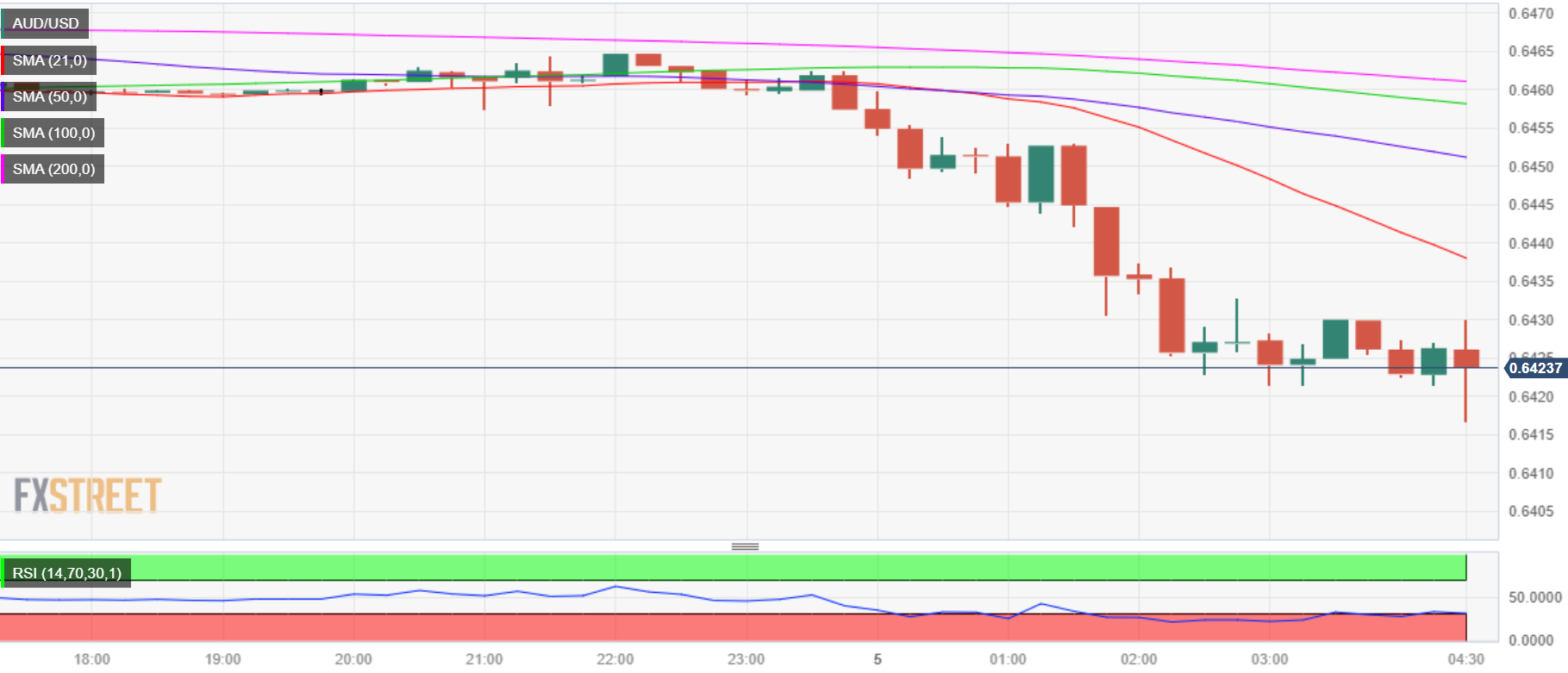Following its September monetary policy meeting, the Reserve Bank of Australia (RBA) announced no change to the Official Cash Rate (OCR), maintaining it at 4.10%, as widely expected.
The RBA’s outgoing Governor, Phillip Lowe, presented his last monetary policy statement, with the key highlights noted below.
Some further tightening of monetary policy may be required.
Board remains resolute in its determination to return inflation to target.
Higher interest rates are working to establish a more sustainable balance between supply and demand in the economy.
Inflation is coming down, the labor market remains strong and the economy is operating at a high level of capacity utilization.
Hold will provide further time to assess the impact of the increase in interest rates to date and the economic outlook.
Inflation is still too high and will remain so for some time yet.
There is increased uncertainty around the outlook for the Chinese economy.
Prices of many services are rising briskly, rent inflation is also elevated.
Services price inflation has been surprisingly persistent overseas and the same could occur in Australia.
Economy is experiencing a period of below-trend growth and this is expected to continue for a while.
The outlook for household consumption also remains uncertain.
AUD/USD reaction
In a knee-jerk reaction to the RBA decision, the AUD/USD pair dropped further to hit intraday lows at 0.6417 before reversing to 0.6428, where it now wavers. The pair is down 0.50% on the day.
AUD/USD: 15-minutes chart
Australian Dollar price today
The table below shows the percentage change of Australian Dollar (AUD) against listed major currencies today. Australian Dollar was the strongest against the New Zealand Dollar.
| USD | EUR | GBP | CAD | AUD | JPY | NZD | CHF | |
| USD | 0.02% | 0.01% | 0.13% | 0.48% | 0.11% | 0.32% | 0.04% | |
| EUR | -0.01% | 0.00% | 0.11% | 0.47% | 0.10% | 0.31% | 0.03% | |
| GBP | -0.02% | 0.00% | 0.12% | 0.47% | 0.13% | 0.33% | 0.03% | |
| CAD | -0.12% | -0.11% | -0.11% | 0.34% | -0.01% | 0.20% | -0.07% | |
| AUD | -0.44% | -0.47% | -0.47% | -0.35% | -0.33% | -0.11% | -0.44% | |
| JPY | -0.12% | -0.10% | -0.11% | 0.02% | 0.37% | 0.21% | -0.09% | |
| NZD | -0.32% | -0.35% | -0.32% | -0.23% | 0.12% | -0.21% | -0.27% | |
| CHF | -0.04% | -0.03% | -0.04% | 0.07% | 0.42% | 0.05% | 0.30% |
The heat map shows percentage changes of major currencies against each other. The base currency is picked from the left column, while the quote currency is picked from the top row. For example, if you pick the Euro from the left column and move along the horizontal line to the Japanese Yen, the percentage change displayed in the box will represent EUR (base)/JPY (quote).
Economic Indicator
Australia RBA Interest Rate Decision
RBA Interest Rate Decision is announced by the Reserve Bank of Australia. If the RBA is hawkish about the inflationary outlook of the economy and rises the interest rates it is positive, or bullish, for the AUD. Likewise, if the RBA has a dovish view on the Australian economy and keeps the ongoing interest rate, or cuts the interest rate it is seen as negative, or bearish.
Read more.This section below was published at 01:30 GMT as a preview of the Reserve Bank of Australia (RBA) policy announcements.
- Interest rate in Australia is likely to remain unchanged at 4.10% in September.
- The Reserve Bank of Australia could leave the door open for more interest rate hikes.
- RBA policy guidance set to ramp up volatility around the Australian Dollar.
The Reserve Bank of Australia (RBA) is set to follow the US Federal Reserve (Fed) and stand pat on Tuesday when it will announce its interest rate decision..
After surprising markets in four out of its last five policy announcements this year, the RBA is likely to offer no fireworks at Governor Philip Lowe’s last policy meeting.
Reserve Bank of Australia interest rate decision: All you need to know on Tuesday, September 5
- AUD/USD is sitting at five-day lows below 0.6450, as the US Dollar clings to recovery gains amid a cautious market mood.
- US S&P 500 futures post small losses, as worries over China’s property sector loom. Meanwhile, the benchmark 10-year US Treasury bond yield recaptures the 4.20% level, up nearly 1% on the day.
- More policy action is expected from China, including relaxing restrictions on home buying. China’s embattled property developer, Country Garden, won approval from its creditors to extend payments for an onshore private bond on Monday.
- China's Caixin Manufacturing Purchasing Managers' Index (PMI) jumped back into expansion territory, coming in at 51.0 in August when compared to July’s contraction of 49.2. The data surprised the market to the upside, as expectations were for a 49.3 reading.
- US Nonfarm Payrolls data showed that employment rose by 187K in August, as against expectations of 170K. However, the previous reading was revised down sharply to 157K. Further, the US Unemployment Rate unexpectedly climbed to 3.8% while the annual Average Hourly Earnings rose 4.3% in August on year, compared with the expected increase of 4.4% in the reported month.
- The RBA interest-rate decision will likely provide near-term direction in the AUD/USD pair amid a relatively data-light week. The Australian central bank’s outgoing Governor Philip Lower is scheduled to deliver a speech titled "Some Closing Remarks" at the Anika Foundation, in Sydney, on Friday.
RBA interest rates expectations: How will it impact AUD/USD?
The Reserve Bank of Australia is widely expected to maintain the Official Cash Rate unchanged at 4.10% following its September monetary policy meeting scheduled on Tuesday. The decision will be announced at 04:30 GMT.
Testifying before the Australian Parliament’s House of Representatives Standing Committee on Economics in early August, RBA Governor Phillip Lowe said, “it is possible that some further tightening of monetary policy will be required to ensure that inflation returns to target within a reasonable timeframe but that will depend upon the data.” “Rates are restrictive so we are in the calibration stage with policy,” he said.
Inflation in Australia has cooled down significantly while the labor market conditions have loosened up, making a perfect case for an extended pause by the RBA. Australia's Consumer Price Index (CPI) inflation slowed to a 17-month low of 4.9% in the year to July. A closely watched measure of core inflation, the trimmed mean, eased to 5.6% from 6.0%.
The country’s Unemployment Rate ticked higher to 3.7% in July, as against the expectations of 3.5% and the previous reading of 3.5%. Employment declined by 14.6K in July, compared with the consensus forecast of a 15K increase and 32.6K jobs addition seen in June. Deteriorating labor market conditions ease pressure on wage growth and demand-driven inflation.
Economists are expecting Governor Lowe to make no changes to the interest rate at his last meeting on September 5, as incoming Governor Michele Bullock takes over the reins on September 18 for a seven-year term. The RBA Governor-Designate said in a speech last week in Canberra that the central bank “may have to raise rates again, but watching data carefully.”
Bullock added, “inflation is still too high, that will be my first priority as governor.” Therefore, it seems that the RBA may leave the door open for more tightening, delivering a mildly hawkish outlook this week.
“Among major local banks, ANZ, CBA, and Westpac expect rates to remain unchanged until at least end-2023 while NAB predicted one more rate hike to 4.35% in November. Slightly less than two-thirds of respondents, 21 of 35, said rates would reach 4.35% or higher by end-year,” findings from the latest survey conducted by Reuters showed.
Economists at Standard Chartered offered their expectations from the RBA going forward, citing: “we lower our terminal rate forecast by 25bps but maintain a 25bps hike projection in November. Recent signs, including lower-than-expected CPI prints, allow RBA to adopt a wait-and-see approach. However, we see little margin for upside surprise to inflation given the already-patient RBA stance.”
The RBA forward guidance is set to rock the Australian Dollar, as traders will closely scrutinize the language in the monetary policy statement for hints on the central bank’s future interest rate path.
Meanwhile, Dhwani Mehta, Asian Session Lead Analyst at FXStreet, notes key technicals to trade AUD/USD on the policy outcome. “AUD/USD is struggling around the 21-day Simple Moving Averages (SMA) at 0.6465 in the run-up to the RBA showdown. The 14-day Relative Strength Index (RSI) holds below the 50 level, keeping the downside risks intact for the Aussie.”
“If the 0.6400 support caves in, then a fresh downswing toward the August low of 0.6364 will be in the offing. Further down, the 0.6300 round figure will be challenged. On the flip side, acceptance above the 0.6522 static resistance is needed to initiate a meaningful recovery toward the 0.6600 level. The next topside barrier is seen at the August 2 high at 0.6630,” Dhwani added.
Interest rates FAQs
What are interest rates?
Interest rates are charged by financial institutions on loans to borrowers and are paid as interest to savers and depositors. They are influenced by base lending rates, which are set by central banks in response to changes in the economy. Central banks normally have a mandate to ensure price stability, which in most cases means targeting a core inflation rate of around 2%.
If inflation falls below target the central bank may cut base lending rates, with a view to stimulating lending and boosting the economy. If inflation rises substantially above 2% it normally results in the central bank raising base lending rates in an attempt to lower inflation.
How do interest rates impact currencies?
Higher interest rates generally help strengthen a country’s currency as they make it a more attractive place for global investors to park their money.
How do interest rates influence the price of Gold?
Higher interest rates overall weigh on the price of Gold because they increase the opportunity cost of holding Gold instead of investing in an interest-bearing asset or placing cash in the bank.
If interest rates are high that usually pushes up the price of the US Dollar (USD), and since Gold is priced in Dollars, this has the effect of lowering the price of Gold.
What is the Fed Funds rate?
The Fed funds rate is the overnight rate at which US banks lend to each other. It is the oft-quoted headline rate set by the Federal Reserve at its FOMC meetings. It is set as a range, for example 4.75%-5.00%, though the upper limit (in that case 5.00%) is the quoted figure.
Market expectations for future Fed funds rate are tracked by the CME FedWatch tool, which shapes how many financial markets behave in anticipation of future Federal Reserve monetary policy decisions.
Information on these pages contains forward-looking statements that involve risks and uncertainties. Markets and instruments profiled on this page are for informational purposes only and should not in any way come across as a recommendation to buy or sell in these assets. You should do your own thorough research before making any investment decisions. FXStreet does not in any way guarantee that this information is free from mistakes, errors, or material misstatements. It also does not guarantee that this information is of a timely nature. Investing in Open Markets involves a great deal of risk, including the loss of all or a portion of your investment, as well as emotional distress. All risks, losses and costs associated with investing, including total loss of principal, are your responsibility. The views and opinions expressed in this article are those of the authors and do not necessarily reflect the official policy or position of FXStreet nor its advertisers. The author will not be held responsible for information that is found at the end of links posted on this page.
If not otherwise explicitly mentioned in the body of the article, at the time of writing, the author has no position in any stock mentioned in this article and no business relationship with any company mentioned. The author has not received compensation for writing this article, other than from FXStreet.
FXStreet and the author do not provide personalized recommendations. The author makes no representations as to the accuracy, completeness, or suitability of this information. FXStreet and the author will not be liable for any errors, omissions or any losses, injuries or damages arising from this information and its display or use. Errors and omissions excepted.
The author and FXStreet are not registered investment advisors and nothing in this article is intended to be investment advice.
Recommended content
Editors’ Picks

Gold trades near record-high, stays within a touching distance of $3,100
Gold clings to daily gains and trades near the record-high it set above $3,080 earlier in the day. Although the data from the US showed that core PCE inflation rose at a stronger pace than expected in February, it failed to boost the USD.

EUR/USD turns positive above 1.0800
The loss of momentum in the US Dollar allows some recovery in the risk-associated universe on Friday, encouraging EUR/USD to regain the 1.0800 barrier and beyond, or daily tops.

GBP/USD picks up pace and retests 1.2960
GBP/USD now capitalises on the Greenback's knee-jerk and advances to the area of daily peaks in the 1.2960-1.2970 band, helped at the same time by auspicious results from UK Retail Sales.

Donald Trump’s tariff policies set to increase market uncertainty and risk-off sentiment
US President Donald Trump’s tariff policies are expected to escalate market uncertainty and risk-off sentiment, with the Kobeissi Letter’s post on X this week cautioning that while markets may view the April 2 tariffs as the "end of uncertainty," it anticipates increased volatility.

US: Trump's 'Liberation day' – What to expect?
Trump has so far enacted tariff changes that have lifted the trade-weighted average tariff rate on all US imports by around 5.5-6.0%-points. While re-rerouting of trade will decrease the effectiveness of tariffs over time, the current level is already close to the highest since the second world war.

The Best brokers to trade EUR/USD
SPONSORED Discover the top brokers for trading EUR/USD in 2025. Our list features brokers with competitive spreads, fast execution, and powerful platforms. Whether you're a beginner or an expert, find the right partner to navigate the dynamic Forex market.
